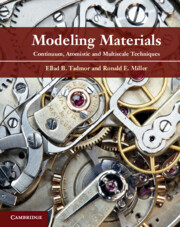Book contents
- Frontmatter
- Contents
- Preface
- Acknowledgments
- Notation
- 1 Introduction
- Part I Continuum mechanics and thermodynamics
- Part II Atomistics
- Part III Atomistic foundations of continuum concepts
- Part IV Multiscale methods
- 10 What is multiscale modeling?
- 11 Atomistic constitutive relations for multilattice crystals
- 12 Atomistic–continuum coupling: static methods
- 13 Atomistic–continuum coupling: finite temperature and dynamics
- Appendix A Mathematical representation of interatomic potentials
- References
- Index
10 - What is multiscale modeling?
from Part IV - Multiscale methods
Published online by Cambridge University Press: 05 June 2012
- Frontmatter
- Contents
- Preface
- Acknowledgments
- Notation
- 1 Introduction
- Part I Continuum mechanics and thermodynamics
- Part II Atomistics
- Part III Atomistic foundations of continuum concepts
- Part IV Multiscale methods
- 10 What is multiscale modeling?
- 11 Atomistic constitutive relations for multilattice crystals
- 12 Atomistic–continuum coupling: static methods
- 13 Atomistic–continuum coupling: finite temperature and dynamics
- Appendix A Mathematical representation of interatomic potentials
- References
- Index
Summary
When we say that a problem in science is “multiscale,” we broadly mean that it involves phenomena at disparate length and/or time scales spanning several orders of magnitude. More importantly, these phenomena all play key roles in the problem, so that we cannot correctly model the interesting behavior without explicitly accounting for these different scales. In Chapter 1, we looked at a wide range of length and time scales relevant to materials modeling, motivating the case that materials science is filled with multiscale problems. Indeed, the message we have tried to carry throughout this book is that there is a need to model materials at many scales, and to make connections between them. However, when we speak of multiscale modeling, we tend to be referring to something more specific, meaning that the problem is tackled with a conscious effort to span multiple scales simultaneously.
In many cases, multiscale methods involve just two scales, a “coarse scale” and “fine scale”, each of which plays a role in the problem. Depending on the perspective, multiscale models offer different advantages. For the fine-scale modeler, a multiscale approach allows one to study much larger systems (or longer times) than could be studied using the finescale alone. On the other hand, the coarse-scale expert views the multiscale model as a way to establish the constitutive laws of the problem from first principles, or at least from a more fundamental scientific basis than could be realized from the coarse-scale alone.
- Type
- Chapter
- Information
- Modeling MaterialsContinuum, Atomistic and Multiscale Techniques, pp. 539 - 549Publisher: Cambridge University PressPrint publication year: 2011



